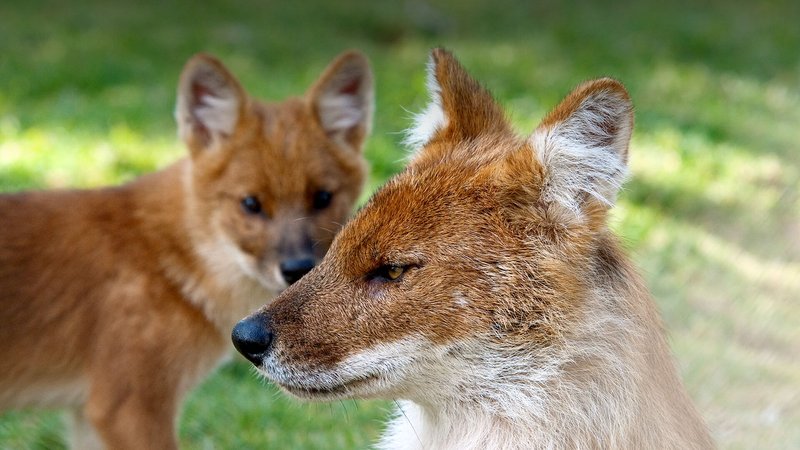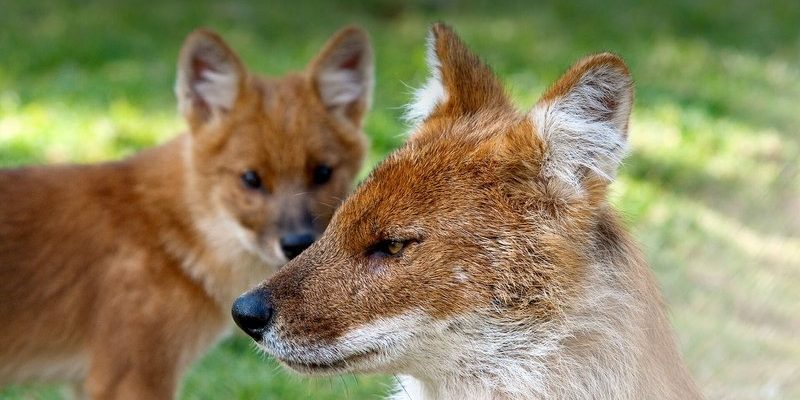
So, how do dholes manage to not just survive but thrive in such challenging environments? It’s all about their adaptability, social structure, and hunting prowess. Let’s dive deeper into the unique strategies that dholes use to overcome the harsh realities of their habitats.
1. The Power of Social Structure
Dholes are incredibly social animals. They live in packs, typically made up of 5 to 12 members, although some packs can be larger. This social structure is vital for their survival. Here’s the thing: being part of a team allows them to hunt more effectively and provide better protection against threats.
Every member of the pack has a role, whether it’s scouting for prey or keeping an eye out for dangers like larger predators. This division of labor is similar to how a football team has different positions, each with its own responsibilities. When hunting, dholes use teamwork to corner and exhaust their prey, working together in a way that maximizes their chances of success.
Moreover, living in a pack helps dholes maintain their social bonds. They communicate through a range of vocalizations, body language, and even scent markings. These interactions strengthen their group dynamics, making the pack more resilient in the face of adversity. Essentially, their social structure isn’t just a way to hunt; it’s a survival strategy.
2. Adaptability to Diverse Habitats
Dholes are found across a wide variety of environments, from the tropical forests of Southeast Asia to the high-altitude grasslands of the Himalayas. What’s fascinating is their ability to adapt to these different habitats. You might be wondering how they do it.
First, dholes are incredibly versatile eaters. They typically hunt large prey, such as deer and wild boar, but they aren’t picky. In lean times, they can also scavenge or take down smaller animals. This flexibility in diet allows them to survive when food is scarce. It’s kind of like being a chef who can whip up a delicious meal with whatever ingredients are on hand.
Second, their physical features help them thrive in various climates. Dholes have long legs and a lean body, making them excellent runners. Their sharp eyesight and keen sense of hearing also enhance their hunting skills. Whether they’re sprinting through a jungle or stealthily moving across rocky terrain, their bodies are built for adapting to the challenges of their environment.
3. Efficient Hunting Techniques
One of the most impressive aspects of dholes is their hunting technique. Unlike many solitary predators that rely solely on stealth, dholes employ a unique blend of endurance and strategy. They often chase their prey over long distances, using their stamina to tire it out. You could think of them as marathon runners in the animal kingdom, where endurance often trumps speed in the end.
Dholes have a high-pitched “yip” that they use to communicate during hunts. This helps them coordinate their efforts and keep track of each other. It’s like having a team of cheerleaders encouraging each other to keep going. When they finally catch their prey, the pack works together to take it down, sharing the spoils among pack members.
Interestingly, their hunting success rate is quite high compared to solitary hunters. This group strategy not only boosts their chances of a successful kill but also reinforces the social bonds within the pack. The sharing of food after a hunt solidifies their connection, which is crucial for their communal survival.
4. Unique Adaptations for Harsh Climates
Dholes have developed several unique traits that help them cope with extreme weather conditions. For starters, their fur acts as insulation against cold weather, while still being breathable enough for warmer climates. This kind of adaptability ensures they can handle both the sweltering heat of the tropics and the chilly air of the mountains. Think of their fur as a smart jacket that adjusts to the temperature.
Additionally, dholes are skilled at finding and utilizing water sources, which is essential in arid environments. Unlike many animals that must roam far to find water, dholes can remember the locations of waterholes and other critical resources. This memory plays a significant role in their survival, especially during dry seasons when water is scarce.
Another fascinating adaptation is their ability to camouflage. Their reddish-brown coats help them blend into their surroundings, whether they’re in a forest or open grassland. This natural disguise aids in both hunting and avoiding larger predators, granting them a stealthy edge in their often harsh environments.
5. Overcoming Threats from Other Predators
Despite their prowess, dholes face numerous threats in the wild, including larger predators like tigers and leopards. Here’s where their social structure truly shines again. When faced with a threat, dholes can come together to fend off intruders. It’s like having a reliable support system; they know they can count on each other.
Another clever tactic is their vocal communication. When they sense danger, they’ll relay warnings through distinct sounds. These alerts allow the pack to regroup or make a strategic retreat when needed. It’s a simple yet effective way to stay one step ahead of potential threats.
Moreover, dholes are known to employ distraction tactics during hunts, which can also protect them from larger predators. For example, if a bigger predator approaches, they may deliberately lead it away from their den or pups, ensuring the safety of their young. Their intelligence and teamwork not only enhance their hunting abilities but also keep them safe in unpredictable situations.
6. The Role of Habitat Conservation
As fascinating as dholes are, they face significant challenges due to habitat loss and human activities. Their survival is closely linked to the health of their environments. When forests are cleared, or grasslands are turned into farmland, dholes lose their homes and hunting grounds. This loss not only threatens their population but also the balance of the ecosystems they inhabit.
Conservation efforts are essential for ensuring that dholes can continue to thrive. Protected areas, wildlife corridors, and education about the importance of preserving habitats can make a big difference. It’s like making sure that the playing field is well-maintained so the team can play the game.
By supporting conservation initiatives, we’re not just helping dholes; we’re also protecting countless other species that share their environment. Every small action counts, from advocating for wildlife protection to making mindful choices about land use.
7. Why Dholes Matter to Ecosystems
Dholes play a crucial role in their ecosystems. As apex predators, they help maintain the balance of the species in their habitats by controlling prey populations. This balance, in turn, supports the health of the ecosystem as a whole. When there are too many herbivores, for instance, vegetation can become overgrazed, leading to soil erosion and other ecological issues. By keeping prey populations in check, dholes help ensure that their habitats remain vibrant and healthy.
Additionally, as dholes scavenge or take down sick or weak animals, they contribute to the overall health of their ecosystems. This process can prevent the spread of diseases that might otherwise affect other wildlife. Think of dholes as nature’s caretakers, promoting biodiversity and helping to sustain the life around them.
In a world where many species are at risk, it’s vital to recognize the importance of creatures like the dhole. Their survival isn’t just about them; it’s a piece of a larger puzzle that affects countless other species and the health of our planet.
Dholes showcase a powerful testament to nature’s resilience and adaptability. From their strong social structures to their unique hunting techniques, these incredible animals are perfectly equipped to navigate the challenges of their harsh environments. As we learn more about dholes, we can appreciate their crucial role in their ecosystems and the importance of protecting their habitats.
By supporting conservation efforts and raising awareness about the plight of the dhole, we take meaningful steps toward ensuring that these remarkable creatures can continue to thrive. So, next time you hear about this intriguing wild dog, remember: their survival is a story of teamwork, adaptability, and the delicate balance of nature.

